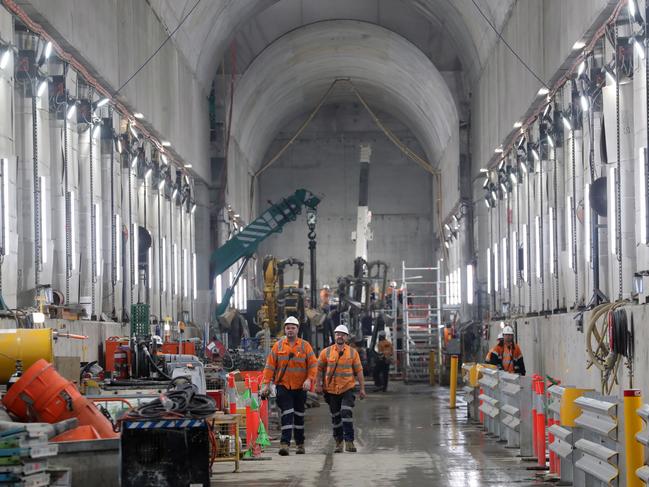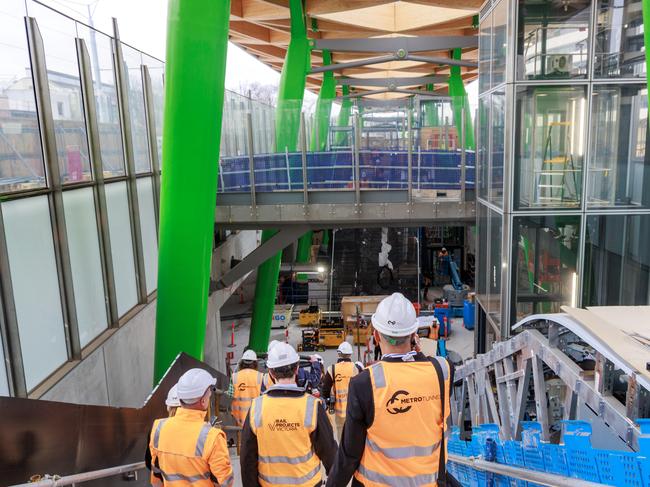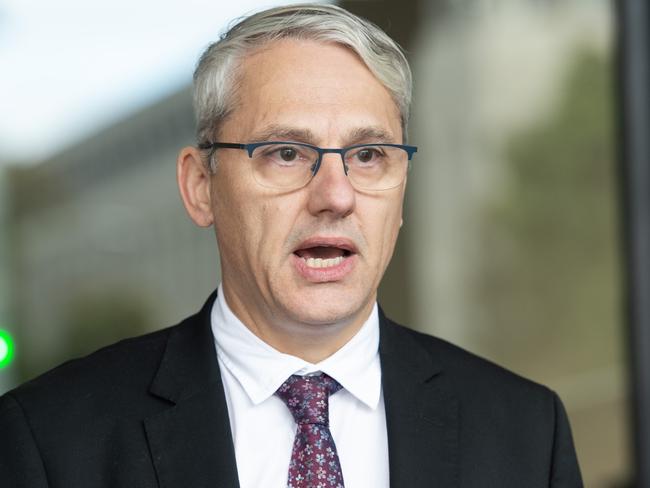Metro Tunnel runs out of funding for unexpected costs, builders to seek taxpayer cash
Treasurer Tim Pallas has said further blowouts on the $14bn Metro Tunnel are “possible” after it ran out of funding set aside for unexpected costs, with builders set to seek more taxpayer cash to finish the city-shaping project.

Victoria
Don't miss out on the headlines from Victoria. Followed categories will be added to My News.
Treasurer Tim Pallas has conceded that further blowouts on the Metro Tunnel are “possible” after it was revealed the project has run out of funding set aside for unexpected costs.
As builders get set to seek more taxpayer cash to finish the $14bn job, Mr Pallas on Thursday could not rule out having to find further funds for the project, admitting that the long-awaited tunnel was facing “cost pressures”.
“At the moment, we’re simply aware of an indication from the contractors who are delivering this project that there are pressures,” he said.
Mr Pallas said the extra costs were yet to be determined.
Warnings that Metro’s “contingency” funds – which are effectively spent when things go wrong – were running low began following Victoria’s Covid-19 shutdowns, and forced parts of the project to be cut back.
But recent cost pressures, which include delays to the two CBD station builds revealed by the Herald Sun, and the complexity of testing trains and communications systems, have tipped the city-shaping project into the red.
The tunnel’s budget has already blown out by more than $3bn, including more than $1.7bn coughed up by taxpayers, but sources familiar with the project said a further injection of cash from the public purse would be inevitable.

Premier Jacinta Allan conceded that there was a “cost escalation that comes over a four-year period”.
“We continue to work with our construction partners on the delivery of this critically important project,” she said.
One industry figure said mega project financiers had a renewed focus on the Metro Tunnel in recent weeks, raising concerns the budget was blown — again.
A government spokesman said the project, which would transform how people travel in Melbourne, was “currently at its most complex phase” that was “testing advanced technology that has never been used on the Victorian rail network”.
“Major projects across Australia and around the world have faced unprecedented challenges in recent years following the once-in-one hundred year pandemic including shortages of materials and skills and the Metro Tunnel is no different,” he said.
“The Metro Tunnel Project engages regularly with its contractors to manage all matters of construction as they arise.”

It comes as a report by the Victorian Auditor General’s Office, tabled in parliament on Thursday, revealed the project was running months behind schedule.
“It is meeting its design and safety requirements, but will not meet the contracted September 2024 completion date,” it said.
“Rail Project Victoria’s revised internal project schedule shows a new completion date in June 2025, which accords with the government’s public commitments to open by the end of 2025.”
The report also confirmed that more funds would be needed to be committed for the project to be finished as there was “insufficient contingency funds” to cover costs.
Despite the revelations, Transport Infrastructure Minister Danny Pearson on Thursday repeatedly denied that contingency funds had been depleted.
“There is still contingency available for this project,” he said.
However, he could not say how much was left and dismissed questions about whether taxpayers would have to fork out more to finish the project.
“The number that was disclosed in the May budget this year, of $12.6m, still holds,” he said.
“If there are any changes to the budget then I’ll disclose them.”
Mr Pearson could not rule out that money would be pulled from untapped contingency funds for the Sunbury Line upgrade — as proposed by Rail Projects Victoria — to address electromagnetic interference costs.
“That work is ongoing,” he said.
“I would imagine that we’re looking at a number of different options to try to address this issue.”

He refused to guarantee that the project would be completed by June 29, as listed in the report, maintaining that it would open at some time in 2025.
“I can’t be specific about that date,” he said.
Opposition transport infrastructure spokesman David Southwick said it looked like “more of the same from a decade-old government that has lost control of our state’s infrastructure pipeline”.
“What else will Jacinta Allan have to cut, close, or cancel to pay for yet another budget blowout?” he said.
When the project was first announced under then premier Daniel Andrews in 2016, the cost was stated as $11bn.
Mr Andrews later revised that down to $10bn.
However, the VAGO report found costs had already blown out to $12.8bn.
The 17 per cent increase is due to an extra $1.37bn for a commercial settlement for the tunnel and stations in 2020. An extra $166m was added for the high-capacity signalling trial and $388 was issued to the builders to cover Covid-19 delays.
The VAGO projected the tunnel and stations works would cost $430m more and this would include addressing the electromagnetic issues.
“Trains moving through the Metro Tunnel will generate electromagnetic interference, which could adversely affect certain medical and scientific equipment in nearby hospitals and research facilities. For example, MRI machines in the Melbourne Biomedical Precinct,” the report said.
“The project’s environmental management framework requires RPV and CYP to work with the affected institutions to mitigate the potential impact of electromagnetic interference.”
In 2022, Mr Greaves released a report on the construction of the tunnel and stations, which noted that “98 per cent of the project’s $740m contingency funding was used or allocated”.
This was after “wider network enhancements” and signalling upgrades were cut back, to offset about $311m of cost overruns that had hit the project since Covid-19 delays.
While that 2022 report notes that a handover to train operators was possible in 2024, the scheduled opening date for passengers remained 2025.
The government has remained confident the new line would be ready by next year, and state budget papers show passengers should be hopping on trains some time after September 30.
The budget also included an extra $233m to “continue preparation activities for the opening of the new Metro Tunnel”, such as trials related to integrating the new line into the broader network.



